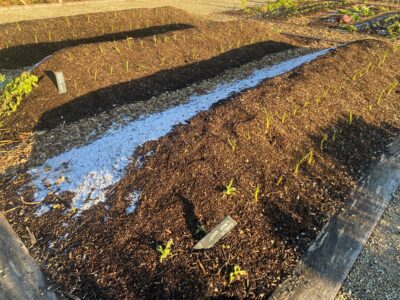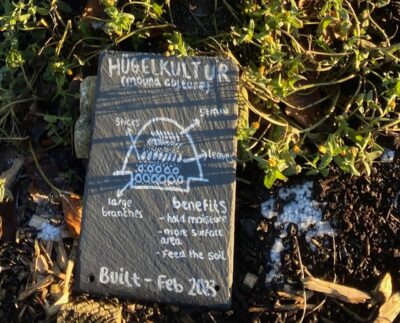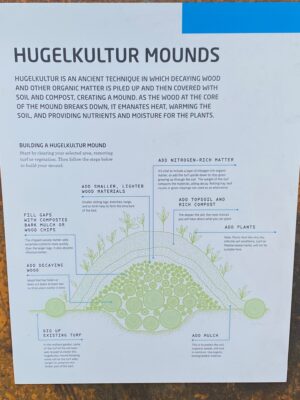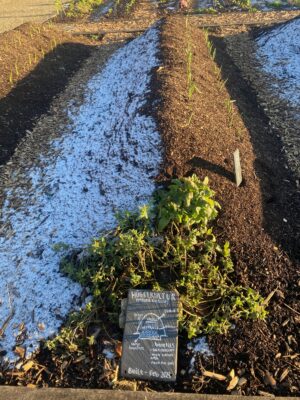
It doesn’t matter how long you have been gardening there is always time to learn something new or change the way you do things.
The greatest thing about gardening (for me anyway) is that there are a hundred and one ways to do the same thing. There may be lots of rules, but you learn by your mistakes and sometimes the rules are unfounded, outdated or simply wrong. In essence there is nothing wrong with breaking a few rules.
In recent months I’ve heard the term Hugelkultur a few times. First at RHS Hampton Court within the RHS Resilient Garden which showcased different ways to support biodiversity. And then on a recent visit to The Newt in Somerset where there were some planted earth works that used the same principle in the vegetable garden. It’s a system that makes sense and one that harness the power of nature to grow. What I can’t fathom is why it has only reached my radar now.
So, what is Hugelkultur?

First it translates as mound culture and it’s actually a very ancient method of growing that makes a lot of sense. It seems to have originated in Germany and spread across Eastern Europe. It’s a growing mound, sometimes described as a raised bed, which I feel is a bit confusing, and is in essence a form of growing that uses layers of organic matter to create a growing system that once working is a bit like treating your garden with steroids.
I’m a bit sad that I didn’t know about it before because it would have been the perfect way to set up my raised beds. But all is not lost because it still has potential in my garden and could be perfect for yours.
How does Hugelkultur work?
Imagine growing your crops on the top of your highly efficient compost heap. A Hugelkultur works a bit like that. At the very bottom of the pile are logs and then branches and then stems, all covered over with layers of organic material. Some of it breaks down fast releasing warmth and nutrients, while other layers like the logs are much slower to decompose. But that’s a good thing because as the microbes and mini beasts work of the wood they use the nitrogen as fuel, so you don’t want too much breakdown too fast otherwise you upset the balance. That’s the same as adding wood chip as a mulch to the garden, you get what is called nitrogen snatch as the microbes steal the nitrogen from the soil to fuel their activity. It’s all about balance, you need the microbe to work on the woody material and they need food, so it’s important to feed the workers by providing a source of nitrogen that stops them stealing too much from the soil. Well-rotted garden compost, worm compost and well-rotted animal bedding (like chicken bedding) is ideal.
The warmth and the action of the microbes creates a healthy mini ecosystem that will support the healthy growth of your plants, especially the fungi which form symbiotic relationships with the plant roots. Plus, the natural materials hold moisture within the soil which becomes available to the plant roots.
But the whole bed will become a habitat and a nesting site for all sorts of mini-beasts like beetles.
How do you make a Hugelkultur?

• If you are filling a new and deep raised bed you can use this layer method to fill it up.
• Or you can dig a hollow in the ground or a trench in a veg patch or raised bed. If you need to lift and remove turf to do this then stack it up as it will be useful to weigh down the wood and keep it in place.
• Start by adding logs to the hollow, ideally it should be timber that has been cut and seasoned.
• Infill with branches and then add a layer of dead twigs and decaying material.
• Then cover over with the upturned turf.
• Cover this over with a thick layer of well-rotted mulch. Empty out your completed compost bin and use this if possible as it will be very rich in all the microbes and mini beasts needed to balance your hügelkultur.
• Now top it off with a generous layer of quality topsoil or garden compost.
• Then it is ready to plant up. Let the fun begin.
What to plant in a Hugelkultur

Once you’ve created your mound you can start planting. It’s ideal for fast cropping salads and any veg that will benefit from the warmth. This is perfect in late winter and early spring, because your crops will get going faster. But you can really experiment with things like herbs and other edibles. Think about the way each side faces, a south facing slope will warm up faster.
Consider setting up a system where the plants support each other. For example use the Three Sisters approach that combines climbing beans, squash and sweetcorn. It was a technique popular in south America. The sweetcorn plants offer support for the climbing beans and the squash create a ground cover layer protecting the soil from evaporation. Together these three types of plants produce a generous harvest.


